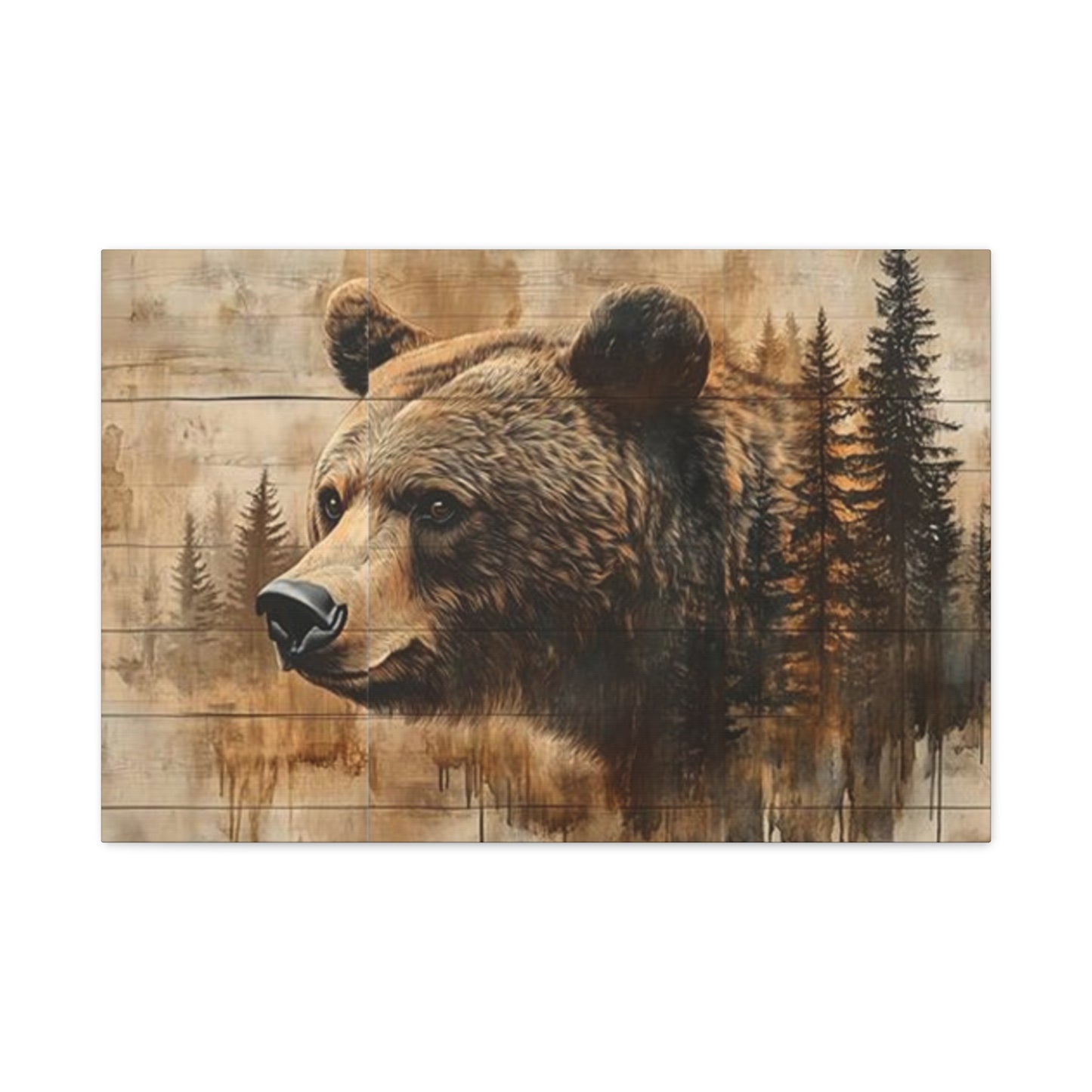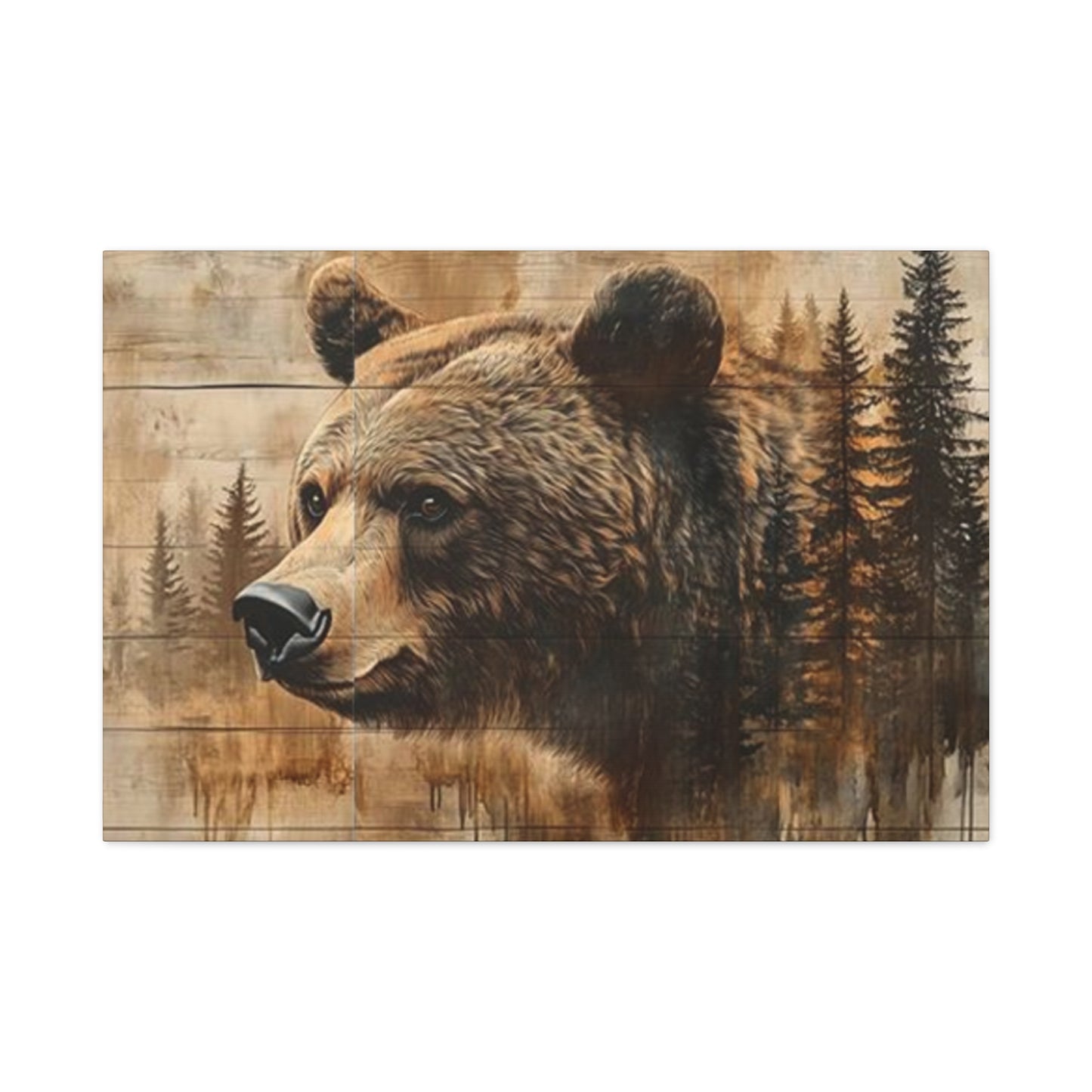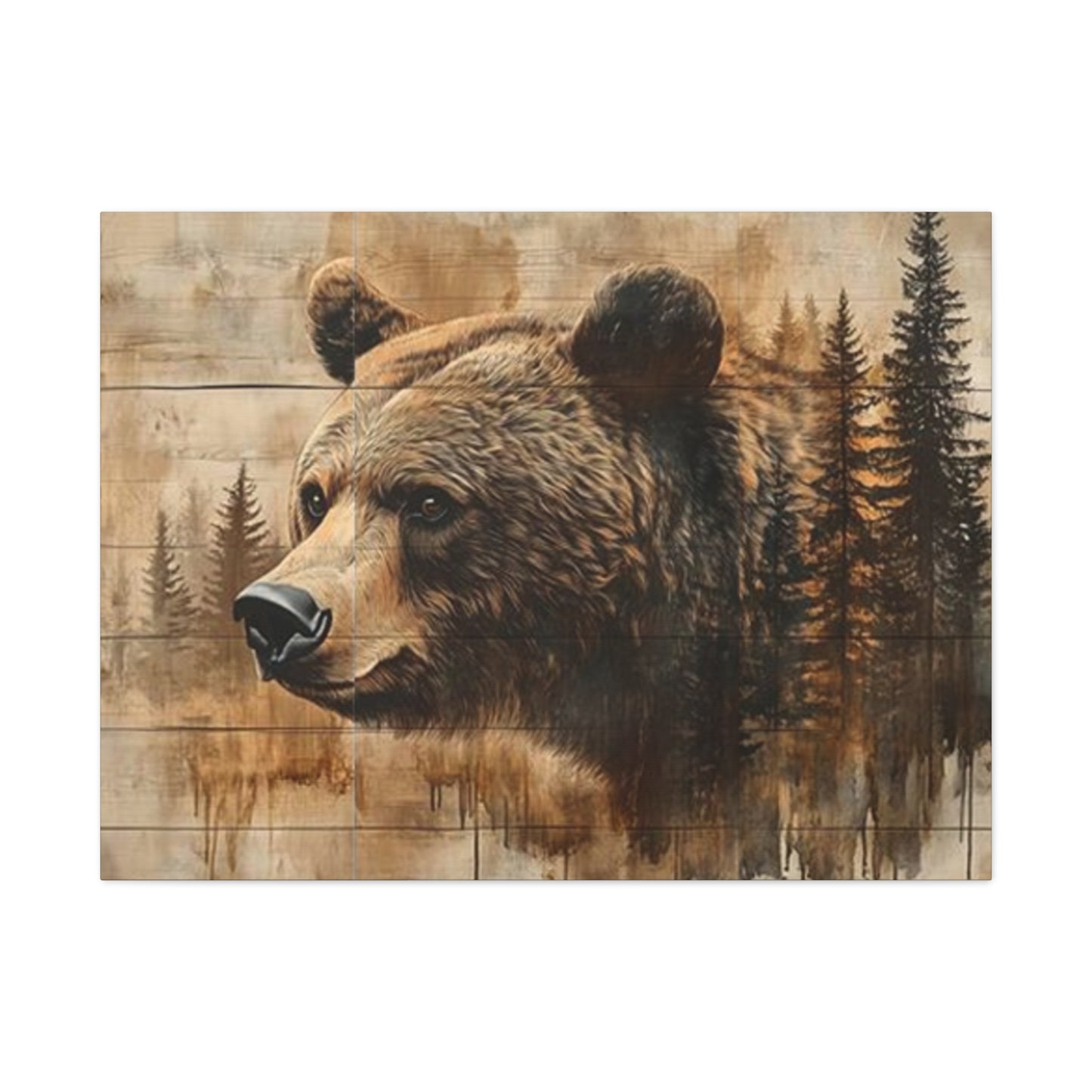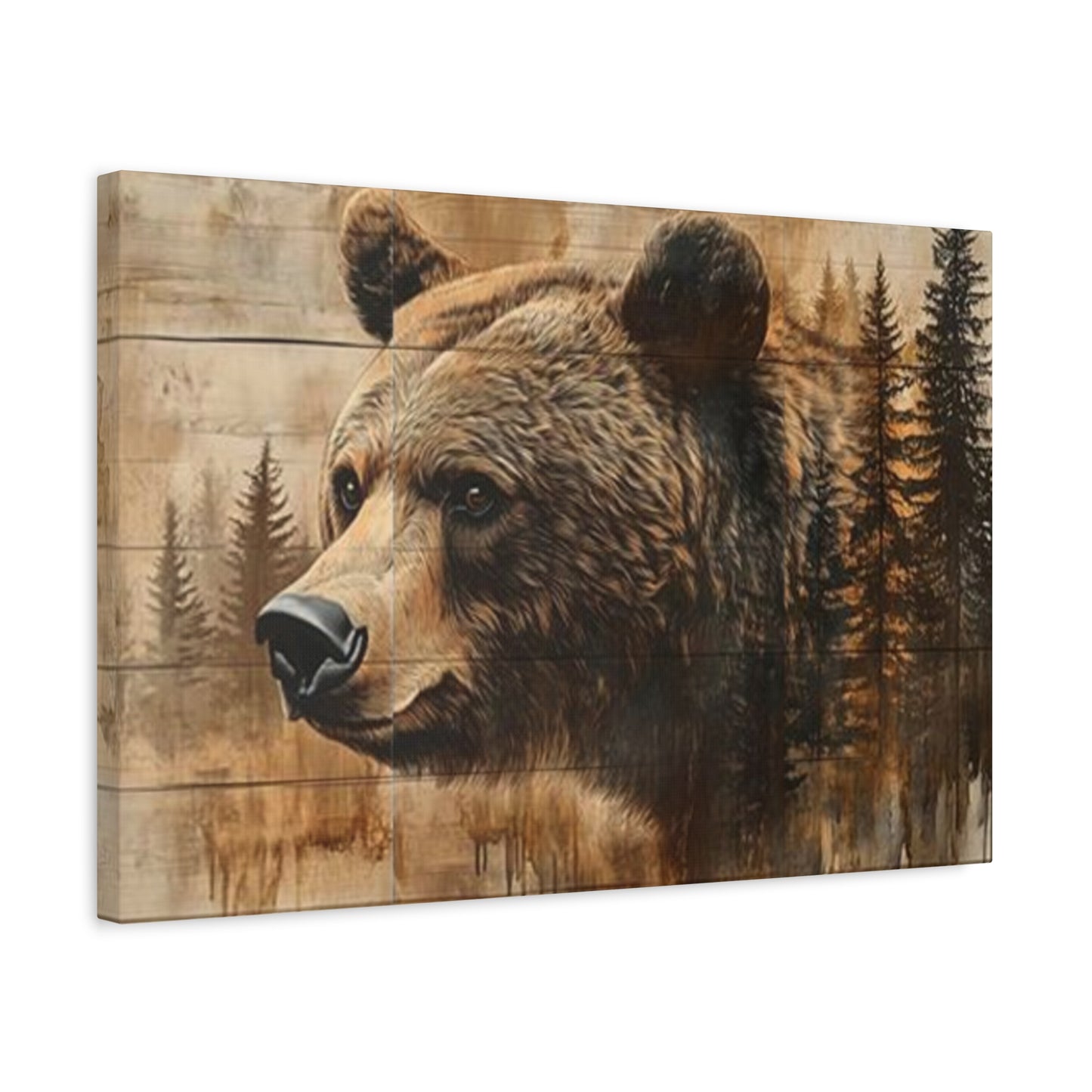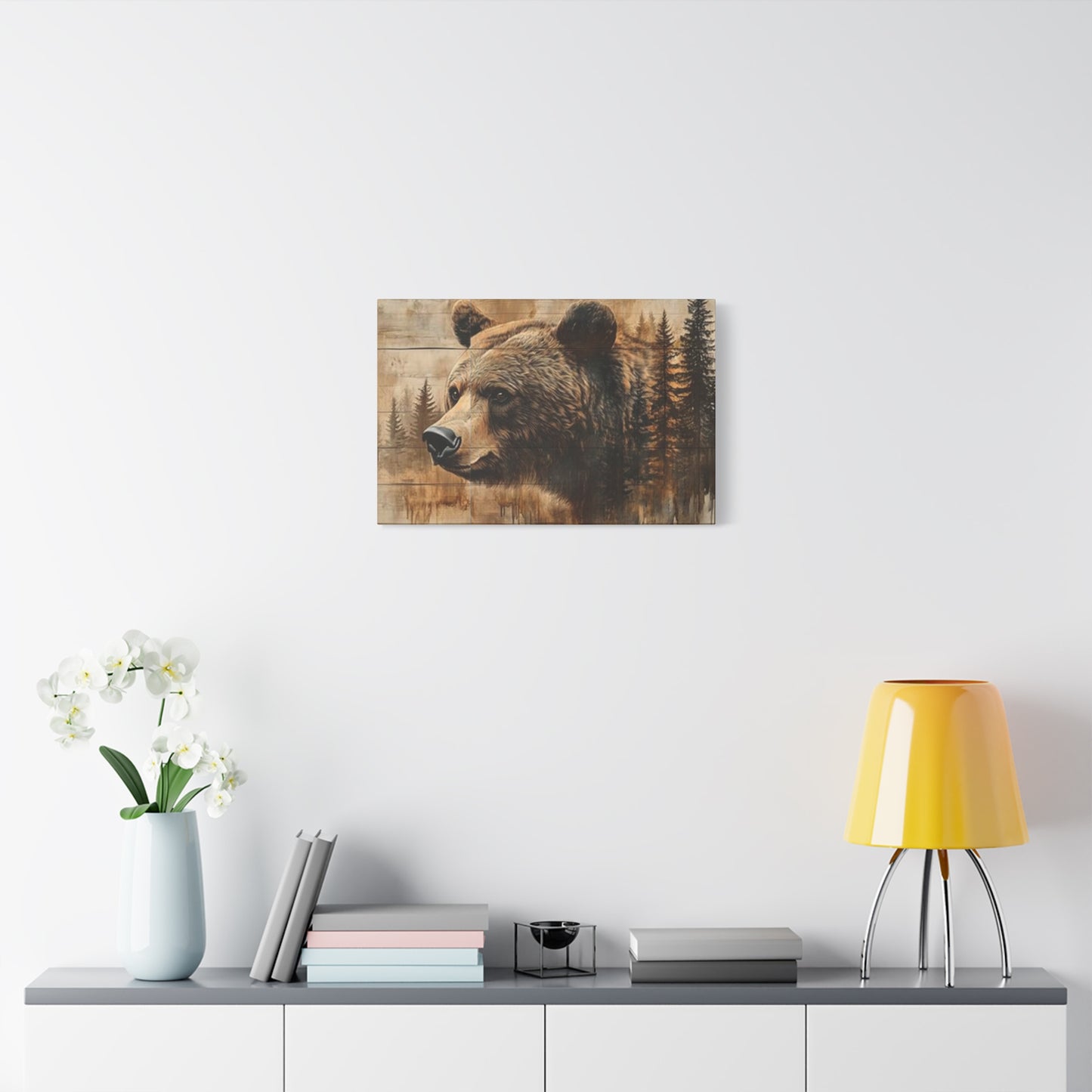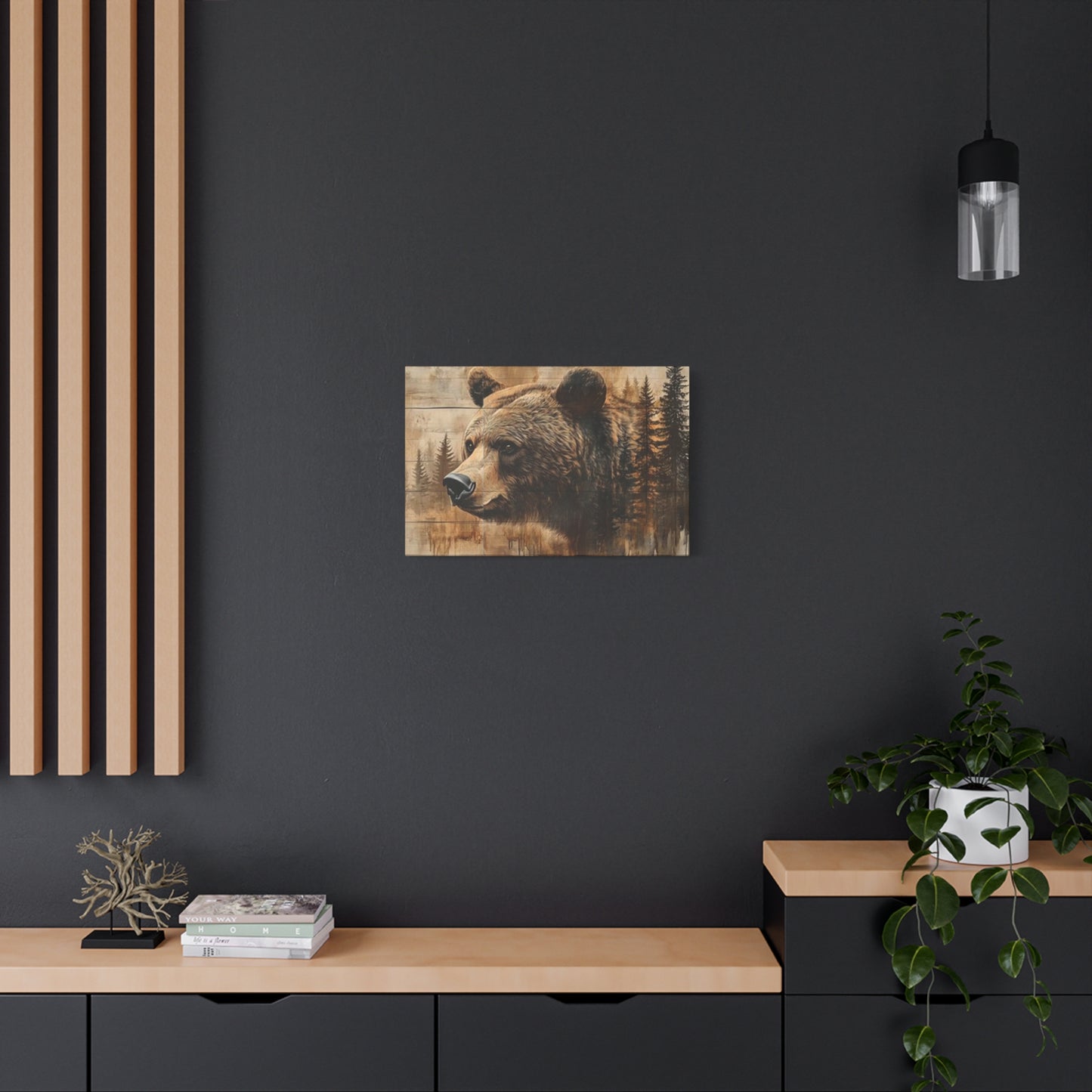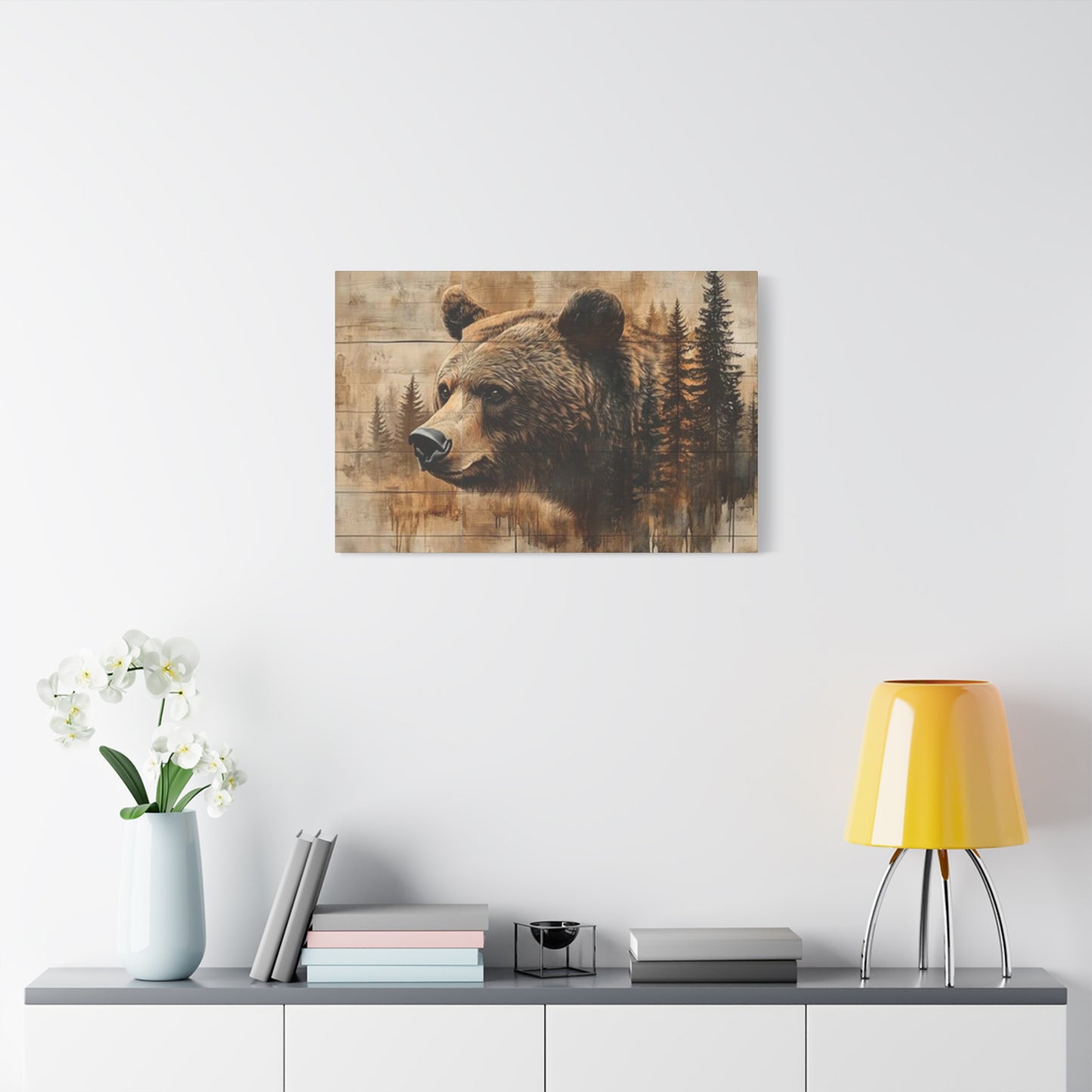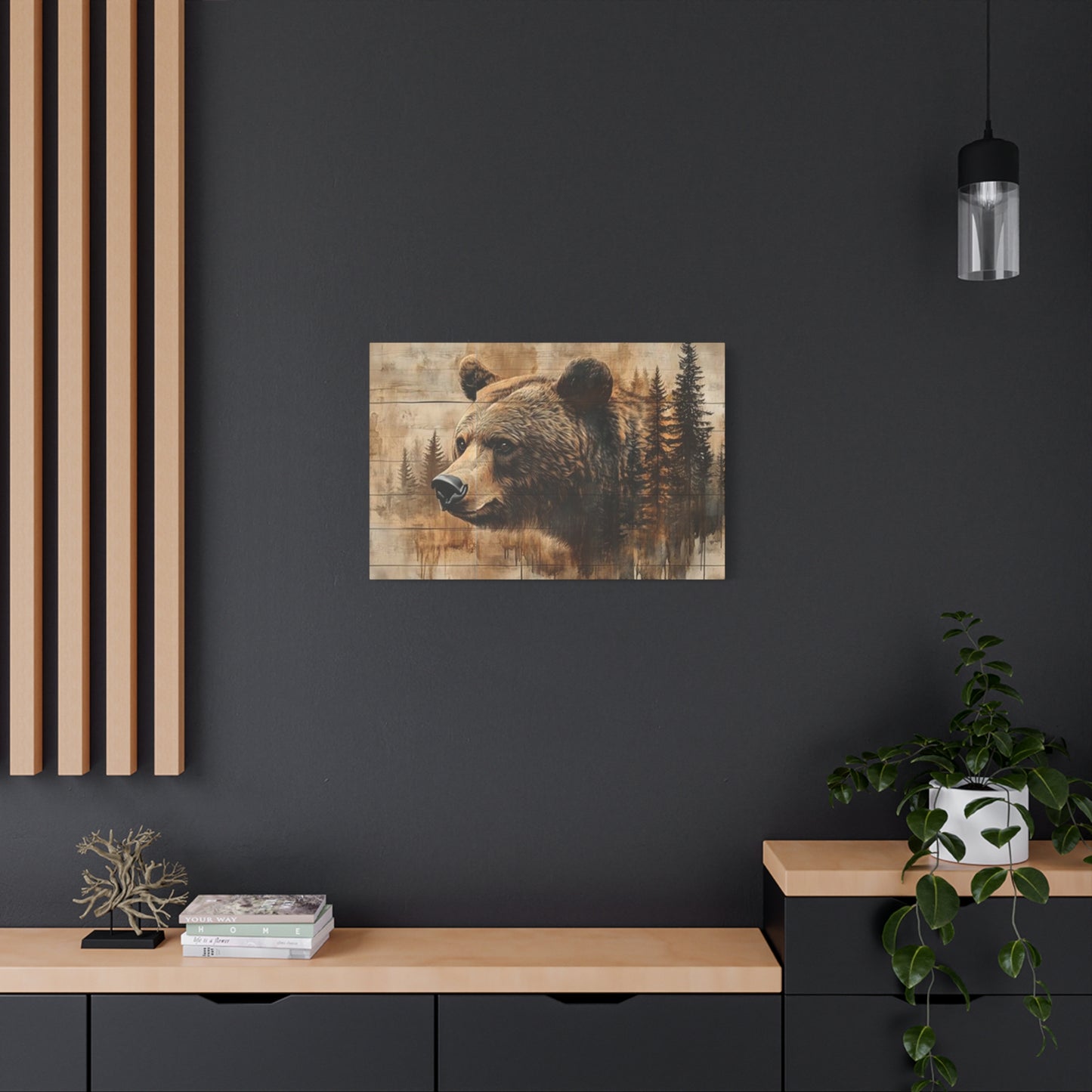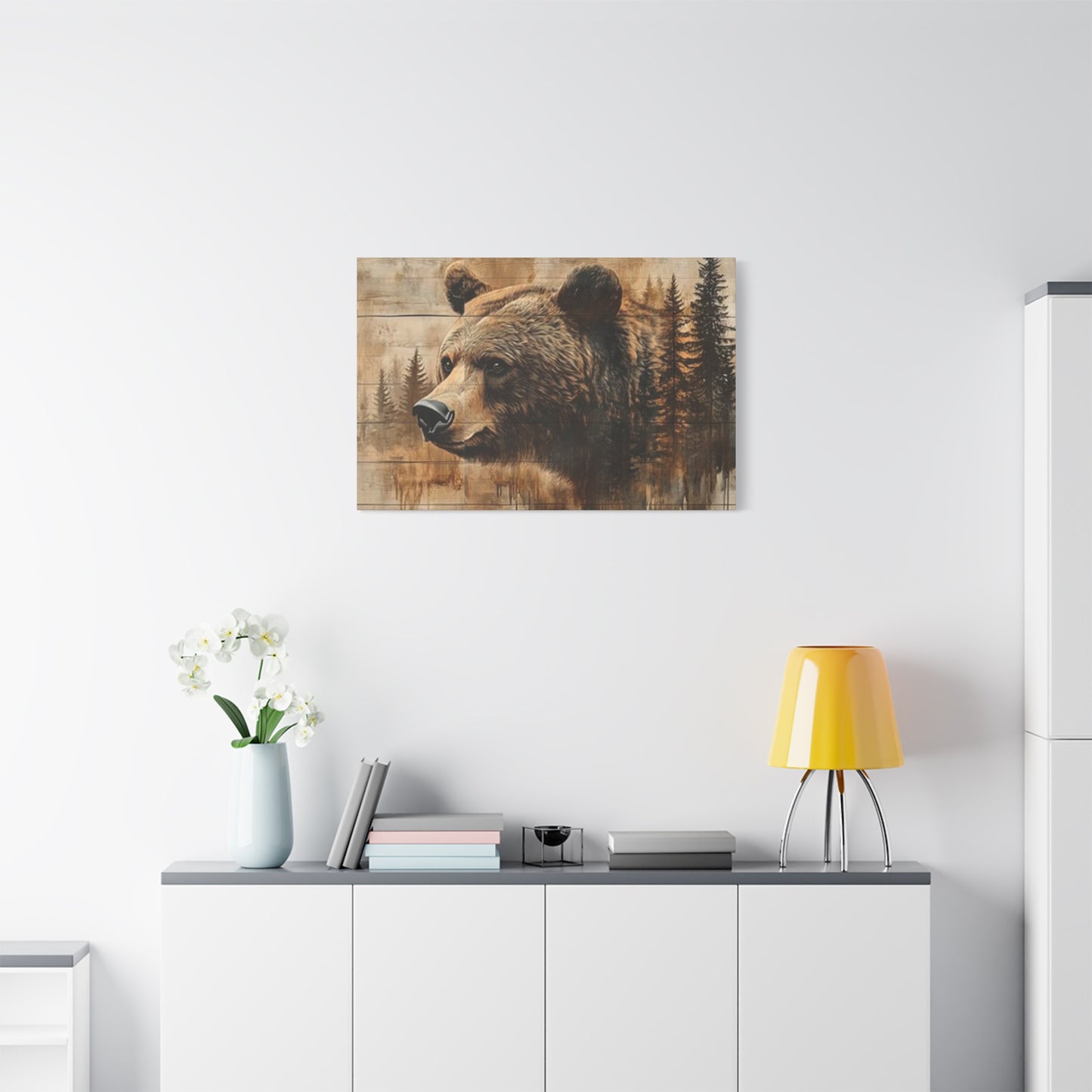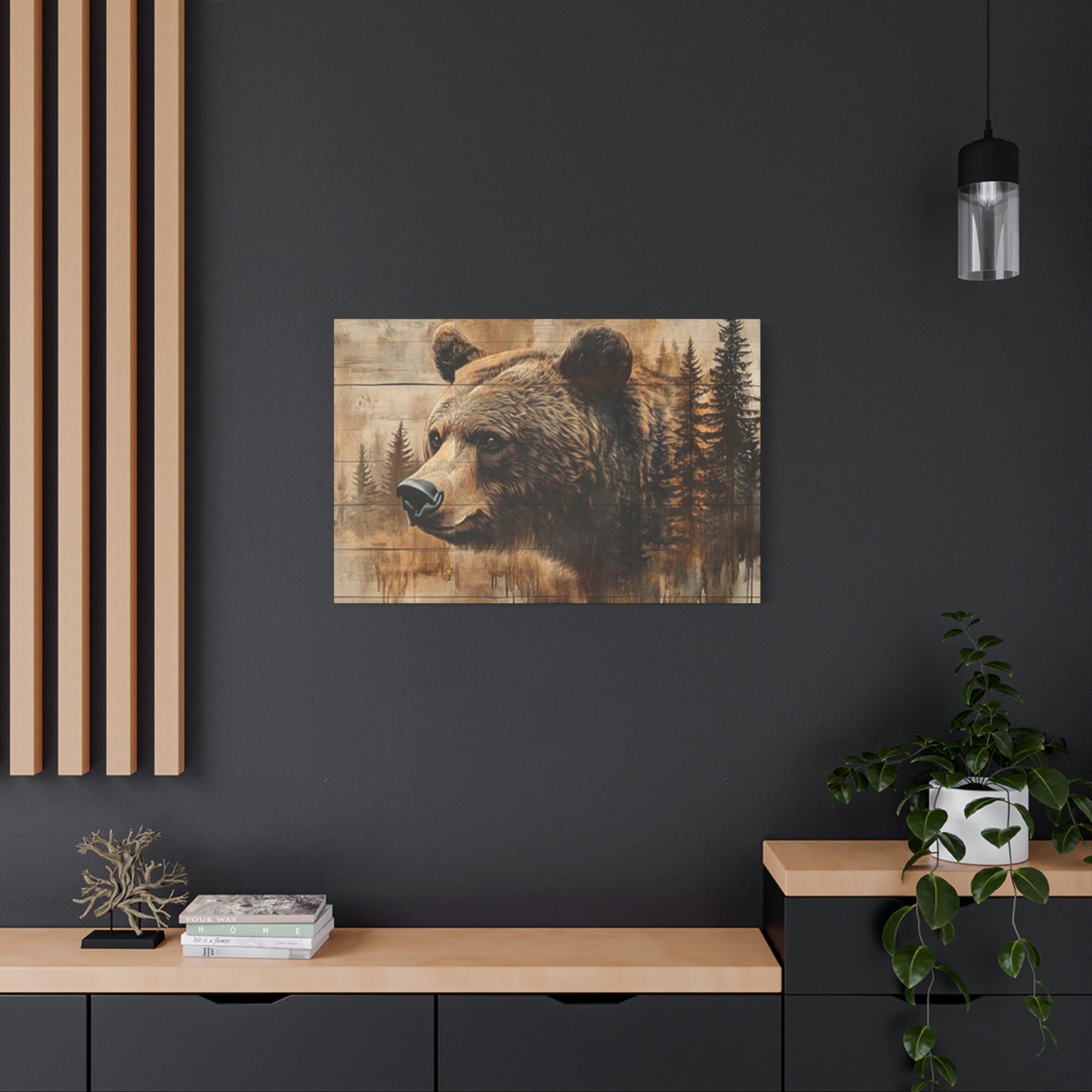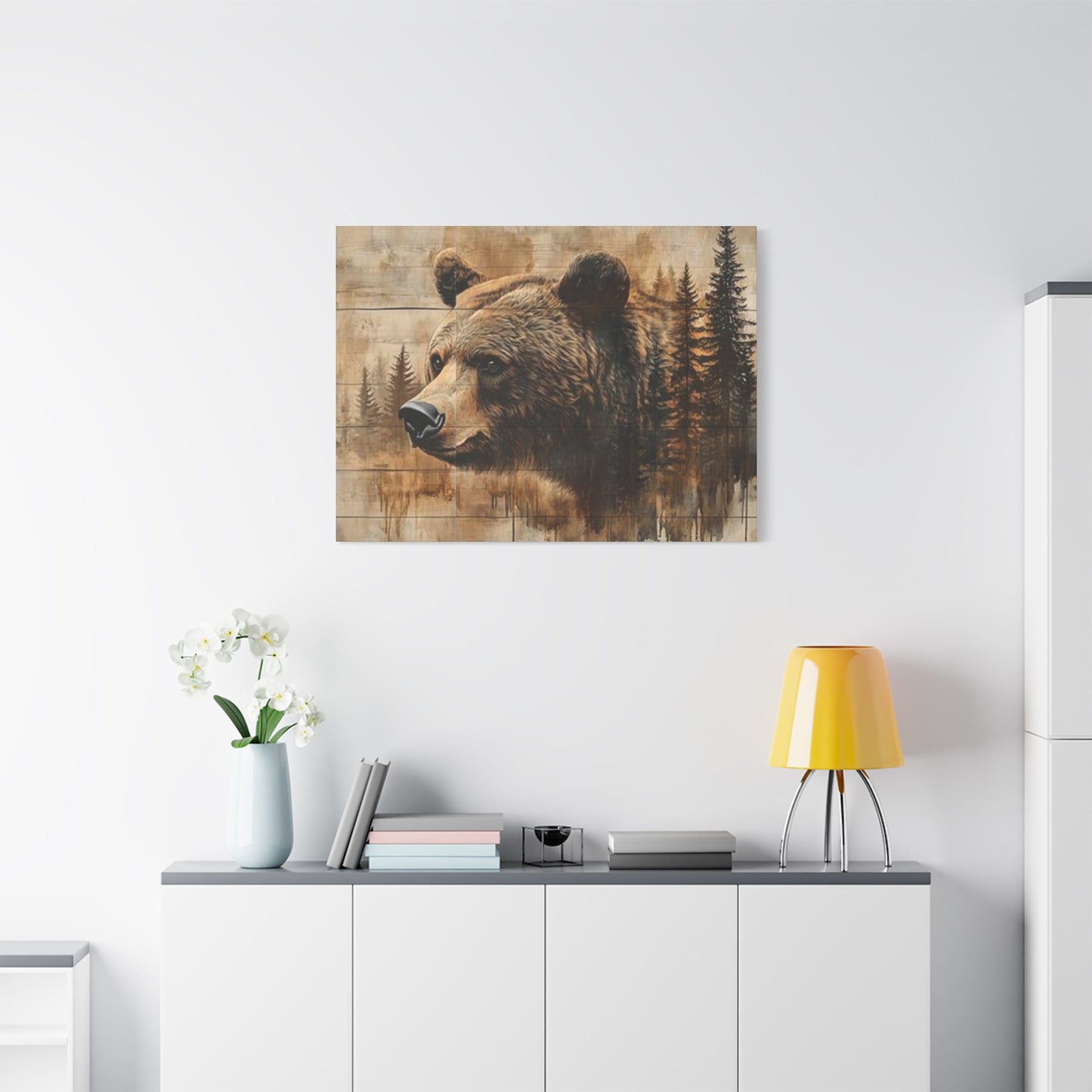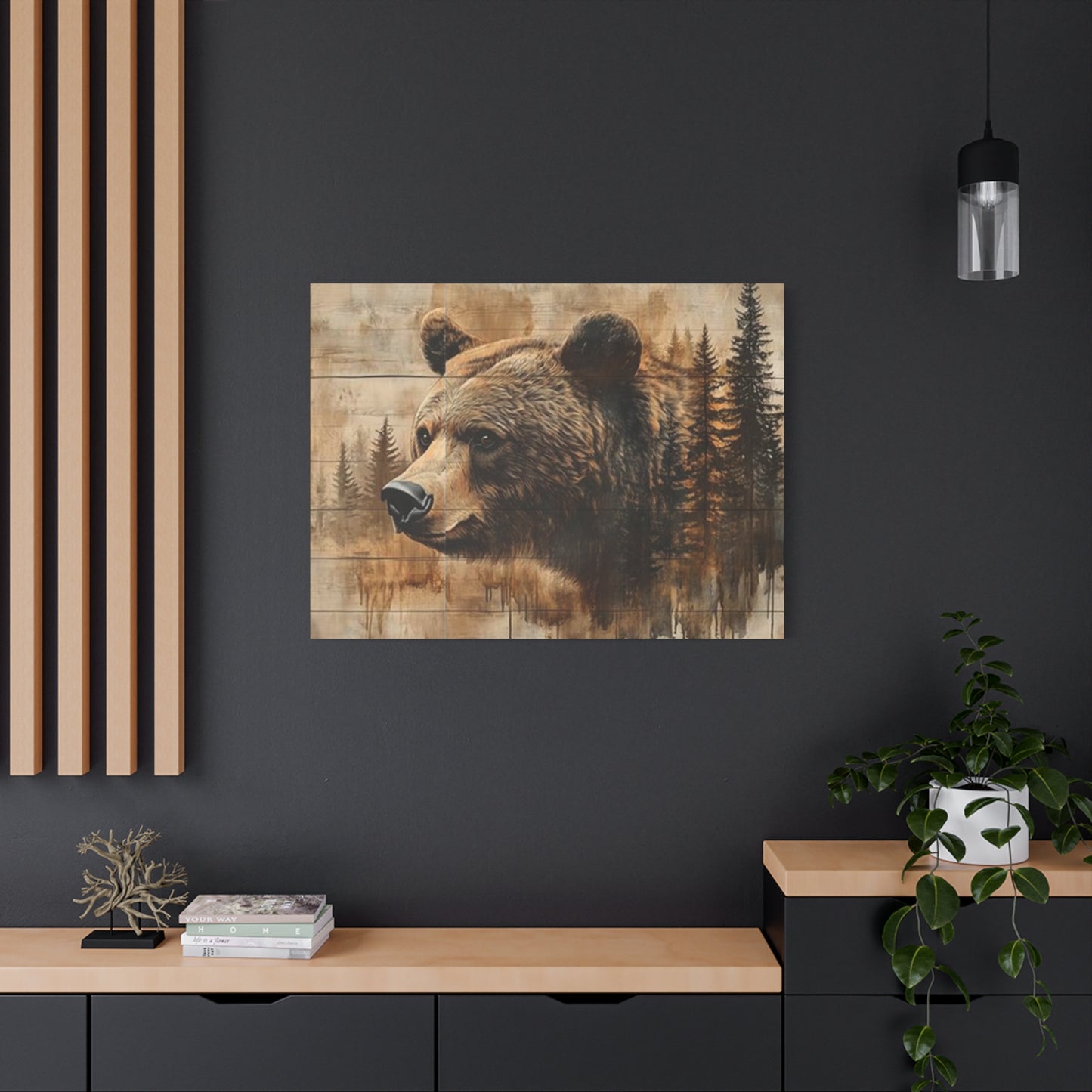Wild Grizzly Bear Portrait Striking Wildlife Wall Art
The magnificent presence of grizzly bears has captivated human imagination for centuries, and now these powerful creatures can grace your living areas through stunning wall art. From photorealistic paintings that showcase every detail of their thick fur to abstract interpretations that capture their essence, grizzly bear artwork offers endless possibilities for transforming any room into a celebration of wilderness beauty. These majestic animals represent strength, wilderness, and the untamed spirit of nature, making them perfect subjects for artwork that commands attention and respect.
When selecting grizzly bear wall art, consider the emotional impact these powerful creatures can bring to your environment. Their imposing stature and commanding presence naturally draw the eye, creating focal points that anchor entire room designs. Whether you prefer traditional oil paintings, contemporary digital art, or mixed media pieces, grizzly bear artwork speaks to our deep connection with the natural world and our fascination with these incredible animals.
The versatility of grizzly bear themed artwork allows it to complement various aesthetic preferences, from rustic cabin atmospheres to modern urban lofts. These pieces serve as conversation starters, educational tools, and sources of daily inspiration, reminding us of the beauty and power that exists in the wild. Professional artists and wildlife photographers have dedicated their careers to capturing the essence of these remarkable creatures, resulting in an extensive collection of high-quality artwork available for home and office decoration.
Authentic Wildlife Artistry Through Grizzly Bear Paintings
Creating authentic grizzly bear paintings requires artists to possess deep understanding of these magnificent creatures' anatomy, behavior, and natural environment. Professional wildlife artists often spend countless hours observing bears in their natural habitats, studying their movements, expressions, and the way light plays across their fur. This dedication to accuracy results in paintings that not only capture the physical appearance of grizzly bears but also convey their personality and spirit.
The most compelling grizzly bear paintings showcase the animal's incredible strength while simultaneously revealing their gentler moments. Artists skilled in wildlife portraiture understand how to balance the bear's intimidating presence with touches of vulnerability, perhaps showing a mother bear with her cubs or a solitary bear contemplating a mountain stream. These emotional layers add depth to the artwork, creating pieces that resonate with viewers on multiple levels.
Traditional painting techniques such as oil on canvas remain popular choices for grizzly bear artwork because they allow artists to achieve the rich textures and subtle color variations found in bear fur. The medium's slow drying time enables artists to blend colors seamlessly, creating the illusion of depth and dimension that brings these creatures to life on canvas. Watercolor techniques offer a different approach, allowing for more fluid, impressionistic interpretations that capture the essence of movement and the ephemeral quality of wildlife encounters.
Contemporary artists are also exploring digital painting techniques to create stunning grizzly bear artwork. These modern approaches allow for incredible detail and the ability to experiment with lighting effects and color palettes that might be challenging to achieve with traditional media. Digital artwork also offers practical advantages such as reproduction flexibility and resistance to fading, making it an excellent choice for long-term display.
The subject matter of grizzly bear paintings varies widely, from close-up portraits that focus on the bear's expressive eyes and facial features to full-body compositions that showcase their impressive size and powerful build. Some artists prefer to depict bears in action, capturing moments of fishing, foraging, or protecting their young, while others focus on quieter scenes that emphasize the contemplative side of these intelligent animals.
Documenting Grizzly Bears Within Their Natural Environment
The natural habitat of grizzly bears provides endless inspiration for artists seeking to create compelling wildlife artwork. These powerful animals inhabit some of the most breathtaking landscapes on Earth, from the dense forests of Alaska to the mountain meadows of the Rocky Mountains. Artists who specialize in habitat documentation understand that the environment plays a crucial role in telling the complete story of these magnificent creatures.
Successful habitat-focused grizzly bear artwork requires careful attention to seasonal changes and environmental details. Spring scenes might feature bears emerging from hibernation in landscapes dotted with wildflowers and fresh green vegetation. Summer compositions often showcase bears fishing in rushing rivers or foraging in berry-rich meadows. Autumn artwork captures the urgency of pre-hibernation feeding, with bears surrounded by golden aspens and salmon-filled streams. Winter scenes, though less common since bears hibernate, can depict the quiet beauty of their sleeping dens beneath snow-covered landscapes.
The challenge of creating authentic habitat artwork lies in accurately representing the complex ecosystems that grizzly bears call home. Artists must understand the plant species, geological formations, water features, and other wildlife that share these environments. This ecological knowledge ensures that the finished artwork presents a believable and educational representation of where these animals actually live and thrive.
Photography serves as an invaluable reference tool for artists working on habitat-based grizzly bear artwork. However, the best wildlife artists go beyond simple photographic reproduction, using their artistic skills to enhance dramatic elements, adjust lighting for better composition, and emphasize the emotional connection between the bear and its environment. This artistic interpretation transforms documentary-style reference material into compelling visual narratives.
Many contemporary wildlife artists are also incorporating conservation messages into their habitat-focused artwork. By depicting grizzly bears in pristine wilderness settings, these pieces serve as reminders of what we stand to lose if we don't protect these critical ecosystems. The artwork becomes a powerful tool for environmental education and advocacy, inspiring viewers to appreciate and protect wildlife habitats.
The technical aspects of creating successful habitat artwork require mastery of landscape painting techniques in addition to animal portraiture skills. Artists must understand how to render various textures found in nature, from the rough bark of ancient trees to the smooth surface of mountain lakes. They must also master atmospheric perspective to create convincing depth in expansive landscape compositions.
Expansive Wildlife Canvas Artwork Featuring Grizzly Bears
Large-scale canvas prints offer an impressive way to showcase grizzly bear artwork, creating dramatic focal points that command attention and respect. These substantial pieces allow viewers to appreciate fine details while experiencing the full impact of the bear's imposing presence. When properly displayed, oversized grizzly bear canvases can transform entire rooms, bringing the power and majesty of the wilderness indoors.
The production of high-quality large-scale grizzly bear prints requires sophisticated printing technology and carefully selected materials. Professional-grade canvas materials provide the durability and texture necessary to support detailed wildlife imagery while maintaining color accuracy over time. The printing process must preserve the subtle gradations and fine details that make wildlife artwork compelling, from individual fur textures to the complex color variations found in natural settings.
Sizing considerations play a crucial role in the effectiveness of large-scale grizzly bear artwork. Pieces measuring 36 by 48 inches or larger create substantial visual impact while remaining manageable for most residential and commercial settings. However, truly impressive installations might feature pieces spanning 60 inches or more, creating immersive experiences that make viewers feel as though they're encountering a real grizzly bear in the wild.
The subject matter chosen for large-scale grizzly bear prints often emphasizes dramatic moments or powerful poses that benefit from expanded presentation. Close-up portraits that fill the frame with the bear's face and upper body create intense emotional connections with viewers. Full-body poses that showcase the animal's impressive size and muscular build work well for larger formats, especially when the composition includes environmental elements that provide scale reference.
Color saturation and contrast become particularly important in large-scale wildlife prints. The increased viewing area means that any deficiencies in color quality or tonal range become more apparent. Professional printers use archival-quality inks and carefully calibrated color management systems to ensure that large grizzly bear prints maintain their visual impact and color accuracy throughout their display lifetime.
The framing and mounting options for large-scale grizzly bear canvas prints require careful consideration of both aesthetic and practical factors. Gallery-wrap techniques that extend the image around the canvas edges eliminate the need for traditional framing while creating clean, contemporary presentations. Alternative mounting systems might include floating frames that add protective borders while maintaining the modern aesthetic that many collectors prefer.
Installation of large-scale grizzly bear artwork requires proper wall anchoring and support systems to ensure safety and longevity. Professional installation services can assess wall structures and recommend appropriate hanging systems that distribute weight evenly and securely. Proper installation not only protects the artwork but also ensures optimal viewing angles and lighting conditions.
Honoring Wildlife Through Grizzly Bear Artistic Expression
Using grizzly bear art as a celebration of wildlife represents a meaningful way to honor these magnificent creatures while supporting conservation efforts and wildlife appreciation. Artistic representations of grizzly bears serve as ambassadors for their species, introducing people to the beauty and importance of these animals in ways that pure scientific documentation cannot achieve. Through art, we can develop emotional connections with wildlife that inspire protective actions and environmental stewardship.
The celebratory aspect of grizzly bear art extends beyond simple decoration to encompass educational and inspirational functions. Well-crafted wildlife artwork tells stories about animal behavior, habitat requirements, and the challenges facing wild populations. These visual narratives can spark curiosity about wildlife biology, conservation needs, and our role in protecting natural ecosystems for future generations.
Artists who dedicate their work to wildlife celebration often develop deep personal connections with their subjects. Many spend years studying grizzly bear behavior, visiting habitats, and building relationships with wildlife biologists and conservationists. This dedication results in artwork that goes far beyond surface representation to capture the true essence and character of these remarkable animals.
The cultural significance of grizzly bears in various societies adds layers of meaning to celebratory artwork. Indigenous cultures have long revered bears as symbols of strength, wisdom, and connection to the natural world. Contemporary artists can draw upon these cultural traditions while creating modern interpretations that speak to current audiences about the ongoing importance of wildlife in our lives.
Celebratory grizzly bear art often emphasizes positive interactions between bears and their environment, showcasing moments of contentment, playfulness, or family bonding. These uplifting representations counter negative stereotypes about bears being primarily dangerous or aggressive animals. By presenting bears in their full behavioral complexity, artists help viewers develop more nuanced and appreciative understanding of these intelligent creatures.
The market for celebratory wildlife art has grown significantly as more people seek meaningful ways to connect with nature despite increasingly urbanized lifestyles. Grizzly bear artwork satisfies this desire by bringing elements of wilderness into homes and offices, serving as daily reminders of the natural world's beauty and importance. This trend supports both artists and conservation organizations that use art sales to fund wildlife protection programs.
Museums and educational institutions increasingly recognize the value of using wildlife art to enhance their conservation messages. Grizzly bear artwork displayed in visitor centers, nature museums, and educational facilities helps create emotional connections that make conservation education more effective. These installations demonstrate how art can serve as a bridge between scientific knowledge and public understanding.
Professional Framing Techniques for Wildlife Bear Artwork
Proper framing significantly enhances the presentation and longevity of grizzly bear artwork while providing protection from environmental factors that could damage these valuable pieces. The framing process for wildlife art requires special consideration of the artwork's subject matter, intended display environment, and preservation requirements. Professional framers who specialize in wildlife art understand how to select materials and techniques that complement the natural themes while ensuring optimal protection.
The choice of frame materials plays a crucial role in the overall aesthetic impact of grizzly bear artwork. Natural wood frames, particularly those featuring rustic finishes or live-edge details, complement the wilderness themes inherent in bear art. Species such as pine, cedar, or reclaimed barn wood create authentic connections to forest environments where grizzly bears live. However, contemporary settings might benefit from sleek metal frames or modern composite materials that provide clean lines without competing with the artwork's natural subject matter.
Matting considerations for grizzly bear art involve balancing color harmony with practical protection needs. Neutral mat colors such as cream, warm white, or light gray typically work well with wildlife subjects, providing visual breathing room without distracting from the artwork. Multiple mat layers can add depth and sophistication to the presentation while creating additional barriers against dust and moisture. Conservation-grade matting materials prevent acid migration that could discolor or damage artwork over time.
Glass selection represents another critical decision in framing wildlife bear art. Standard glass provides basic protection but can create reflections that interfere with viewing, particularly problematic for detailed wildlife artwork where texture and fine details are important. Museum-quality glass with anti-reflective coatings eliminates these viewing obstacles while providing superior UV protection that prevents fading. Acrylic alternatives offer lightweight benefits and shatter resistance, making them suitable for large-scale pieces or high-traffic environments.
The spacing between artwork and glazing, known as the air gap or reveal, prevents the print surface from contacting the glass and allows for thermal expansion without damage. Wildlife artwork often benefits from generous reveals that create shadow lines enhancing the three-dimensional appearance of the framed piece. Professional framers use precision spacers to maintain consistent gaps around the entire perimeter.
Backing materials and mounting techniques require careful selection to provide adequate support without causing long-term damage to the artwork. Acid-free foam boards or honeycomb panels provide rigid support for canvas prints while remaining lightweight enough for comfortable handling. The mounting adhesives must be archival quality and fully reversible to meet museum standards for artwork preservation.
Hanging hardware selection depends on the size and weight of the framed grizzly bear artwork. Professional-grade wire, D-rings, or cleat systems distribute weight appropriately and provide secure attachment points. For valuable pieces, security features such as special screws or alarm contacts might be incorporated into the hanging system to prevent theft while maintaining accessibility for cleaning and maintenance.
Strength and Magnificence of Grizzly Bears in Artistic Representation
The inherent power and majesty of grizzly bears make them compelling subjects for artists seeking to create impactful visual statements. These massive predators embody raw strength and untamed wilderness in ways that few other animals can match, providing artists with rich opportunities to explore themes of power, dignity, and natural authority. Successful artistic representation of grizzly bear majesty requires understanding both the physical attributes that make these animals impressive and the behavioral characteristics that reveal their complex personalities.
Physical strength manifests in grizzly bear art through careful attention to anatomical accuracy and muscular definition. Artists must understand the bear's powerful shoulder structure, massive claws, and robust build to create convincing representations of their strength. The challenge lies in depicting this physical power without making the animals appear cartoonish or overly aggressive. Skilled wildlife artists achieve this balance by studying bear anatomy extensively and observing how these animals carry themselves in various situations.
The majestic qualities of grizzly bears extend beyond mere physical attributes to encompass their behavioral dignity and intelligence. Mature bears, particularly large males, carry themselves with a confidence and presence that commands respect from other wildlife and human observers alike. Artists capture this majesty through careful attention to posture, facial expression, and the bear's interaction with its environment. A truly majestic grizzly bear artwork conveys the animal's awareness of its own power while suggesting the wisdom that comes with surviving in challenging wilderness environments.
Color selection plays a vital role in conveying the power and majesty of grizzly bears in artwork. The natural color palette of bear fur ranges from light blonde to deep brown, often with silver-tipped guard hairs that create complex visual textures. Artists use these color variations to model form and suggest the density of the bear's protective coat. Dramatic lighting effects can enhance the sense of power by creating strong contrasts between light and shadow across the bear's muscular form.
Environmental context contributes significantly to the majestic presentation of grizzly bears in art. Placing bears in appropriately scaled landscapes helps viewers appreciate their impressive size, while dramatic natural settings such as mountain peaks or roaring waterfalls complement the bear's own commanding presence. The key is ensuring that environmental elements support rather than compete with the bear as the primary focus of the composition.
The psychological impact of majestic grizzly bear art extends far beyond simple decoration to create emotional experiences for viewers. These powerful images can evoke feelings of awe, respect, and connection to the natural world that persist long after viewing. This emotional resonance makes grizzly bear art particularly effective in settings where inspiration and motivation are desired, such as offices, lodges, or educational facilities.
Contemporary interpretations of grizzly bear power and majesty might incorporate abstract elements or stylized approaches that emphasize emotional impact over photographic accuracy. These artistic interpretations can capture the essence of bear strength through bold brushstrokes, dramatic color combinations, or simplified forms that focus attention on the most powerful aspects of the bear's presence.
Harmonizing Forest Landscapes with Grizzly Bear Artwork
The integration of forest scenes with grizzly bear art creates comprehensive visual narratives that transport viewers into the heart of wilderness environments. This artistic approach recognizes that grizzly bears cannot be fully understood or appreciated when separated from their natural habitats. By combining detailed forest landscapes with bear subjects, artists create immersive experiences that educate viewers about ecosystem relationships while providing stunning decorative elements.
Forest environments provide rich compositional opportunities for grizzly bear artwork, offering vertical elements from towering trees, horizontal features from fallen logs and streams, and diagonal lines from mountainsides and rock formations. These varied elements allow artists to create dynamic compositions that guide the viewer's eye through the artwork while maintaining focus on the bear subject. The challenge lies in balancing environmental detail with animal prominence to ensure the bear remains the primary focal point.
Seasonal forest changes offer diverse palette options for grizzly bear habitat artwork. Spring forests feature fresh green foliage and wildflower accents that create optimistic, renewal-themed compositions. Summer scenes showcase the full density of forest canopies with deep greens and dappled lighting effects. Autumn forests provide spectacular color opportunities with golden aspen groves and brilliant maple displays that complement the rich brown tones of grizzly bear fur. Winter scenes, though less common due to hibernation patterns, can depict the quiet beauty of snow-covered forests preparing for the bears' return.
The technical challenges of combining forest landscapes with grizzly bear subjects require artists to master multiple painting disciplines. Landscape techniques for rendering trees, rocks, water, and atmospheric effects must be seamlessly integrated with wildlife portraiture skills needed for accurate bear representation. This dual expertise demands years of study and practice, explaining why successful wildlife habitat artists are highly valued in the art market.
Light quality plays a crucial role in unifying forest and bear elements within cohesive compositions. Forest environments create complex lighting conditions with filtered sunlight, deep shadows, and reflected light from various surfaces. Artists must understand how these lighting conditions affect both the forest elements and the bear subject to create believable integrated scenes. Dramatic lighting can enhance the mood and emotional impact while serving practical compositional functions.
Scale relationships between forest elements and grizzly bears help viewers understand the impressive size of these animals. Including familiar objects such as trees, rocks, or streams provides reference points that emphasize the bear's massive proportions. However, artists must be careful not to make environmental elements too large or small, as incorrect scale relationships can undermine the artwork's credibility and impact.
The ecological accuracy of forest-bear combinations requires research into actual habitat preferences and seasonal patterns. Grizzly bears favor certain forest types and elevations depending on food availability and seasonal cycles. Knowledgeable artists ensure that their forest settings accurately reflect the environments where bears actually live and hunt, adding educational value to the decorative appeal of their artwork.
Building Emotional Bonds Through Wildlife Paintings
Wildlife paintings, particularly those featuring grizzly bears, possess unique abilities to create profound emotional connections between viewers and the natural world. These artistic works transcend mere visual representation to become conduits for empathy, understanding, and appreciation of wildlife. The emotional power of well-crafted grizzly bear paintings stems from artists' abilities to capture not just physical appearance but also the personality, intelligence, and emotional complexity of these remarkable animals.
The process of creating emotionally resonant grizzly bear artwork requires artists to develop deep understanding of bear behavior and psychology. Bears exhibit complex emotional states including playfulness, protectiveness, curiosity, and contentment that skilled artists can convey through careful attention to facial expressions, body language, and situational context. Mother bears with cubs offer particularly powerful emotional subjects, showcasing the universal themes of parental love and protection that resonate across species boundaries.
Viewers' emotional responses to grizzly bear artwork often reflect their own relationships with nature and wildlife. Urban dwellers might experience nostalgia for wild places they've never visited, while rural residents may feel connections to landscapes they know intimately. These personal responses transform wildlife paintings from simple decorations into meaningful additions to living and working environments that provide daily inspiration and comfort.
The therapeutic benefits of wildlife art have gained recognition in healthcare and wellness settings. Grizzly bear paintings can provide calming influences in stressful environments while offering opportunities for contemplation and mental escape. The natural subjects and often peaceful compositions create atmospheres conducive to relaxation and healing, making wildlife art valuable additions to medical facilities, counseling centers, and wellness retreats.
Educational institutions use emotionally engaging wildlife artwork to enhance learning experiences and environmental awareness. Grizzly bear paintings in classrooms and nature centers create immediate connections that make conservation education more effective. Students who feel emotional connections to wildlife through art are more likely to develop lasting interests in environmental protection and natural sciences.
The conservation implications of emotional wildlife art extend beyond individual responses to collective action. When people develop emotional attachments to grizzly bears through compelling artwork, they become more invested in conservation efforts and habitat protection. This emotional engagement translates into support for wildlife organizations, national parks, and environmental legislation that benefits bear populations and their ecosystems.
Artists working in emotionally-focused wildlife art often report profound personal transformations through their work. The process of deeply studying and representing grizzly bears creates lasting connections that influence artists' worldviews and life choices. Many become active conservationists themselves, using their artistic platforms to advocate for wildlife protection and environmental awareness.
Rustic Aesthetic Enhancement with Grizzly Bear Wildlife Prints
Grizzly bear wildlife prints serve as perfect complements to rustic decor schemes, enhancing the natural, outdoorsy atmosphere that characterizes this popular design approach. The inherent wildness and strength of grizzly bears align perfectly with rustic themes that celebrate simplicity, natural materials, and connections to outdoor lifestyles. These powerful images bring elements of untamed wilderness into carefully crafted rustic environments, creating authentic atmospheres that speak to our deep-seated appreciation for natural beauty.
The color palettes typically found in grizzly bear artwork harmonize beautifully with traditional rustic color schemes. The rich browns of bear fur complement wood tones found in rustic furniture and architectural elements. Earth tones present in natural bear habitats, including forest greens, stone grays, and sky blues, coordinate with the muted color palettes that characterize successful rustic design. This natural color harmony ensures that grizzly bear prints integrate seamlessly into existing rustic environments.
Material considerations for displaying grizzly bear prints in rustic settings often favor natural options that reinforce the outdoor theme. Reclaimed wood frames weathered by time and elements provide authentic backdrops that enhance rather than compete with wildlife subjects. Metal frames with aged finishes or naturally rusted patinas can also work well, particularly in rustic settings that incorporate industrial elements alongside natural materials.
Scale selection becomes particularly important when incorporating grizzly bear prints into rustic decor schemes. These environments often feature substantial architectural elements such as exposed beams, stone fireplaces, and oversized furniture that can overwhelm small artwork. Large-scale grizzly bear prints hold their own against these substantial elements while maintaining the bold, dramatic presence that rustic environments demand.
The storytelling aspect of rustic design finds perfect expression through grizzly bear wildlife prints that capture authentic wilderness moments. Images of bears fishing in mountain streams, foraging in meadows, or standing majestically against mountain backdrops tell stories about outdoor adventures and wild places that resonate with rustic design philosophies. These narrative elements transform wildlife prints from simple decorations into conversation pieces that enhance the overall atmospheric goals of rustic environments.
Lighting considerations play crucial roles in maximizing the impact of grizzly bear prints within rustic settings. Warm lighting sources such as firelight or amber-toned fixtures enhance the cozy atmosphere while bringing out the rich colors and textures present in wildlife artwork. Avoiding harsh fluorescent or cool LED lighting preserves the warm, inviting atmosphere that makes rustic environments so appealing.
The authenticity that rustic design seeks to achieve benefits enormously from the genuine nature of wildlife subjects. Grizzly bears represent real wilderness experiences and authentic natural beauty that cannot be replicated through artificial or manufactured design elements. This authenticity reinforces the overall credibility of rustic design schemes while providing focal points that anchor entire room compositions.
Perfect Wildlife Gift Options: Grizzly Bear Art
Grizzly bear artwork represents exceptional gift choices for wildlife enthusiasts, nature lovers, and anyone who appreciates the majesty of North America's most impressive predator. These powerful images serve as thoughtful presents that demonstrate understanding of the recipient's interests while providing lasting decorative value. The universal appeal of grizzly bears crosses age and gender boundaries, making this artwork suitable for diverse gift-giving occasions and recipient preferences.
The emotional significance of grizzly bear art as gifts extends far beyond typical decorative items. Recipients often develop personal connections to wildlife artwork that remind them of outdoor experiences, conservation values, or simply their appreciation for natural beauty. These emotional connections transform wildlife prints into meaningful keepsakes that maintain their significance long after the initial gifting occasion, creating lasting memories associated with the giver's thoughtfulness.
Occasion versatility makes grizzly bear artwork appropriate for numerous gift-giving situations. Birthday presents for outdoor enthusiasts, retirement gifts for nature lovers, housewarming presents for cabin owners, and holiday gifts for conservationists all benefit from the timeless appeal of wildlife art. The permanent nature of quality artwork ensures that these gifts provide enjoyment for years or even decades, offering exceptional value compared to consumable or temporary presents.
Size and format options allow gift-givers to select grizzly bear artwork appropriate for various budgets and display requirements. Small prints suitable for desk or shelf display provide affordable options that still deliver significant visual impact. Medium-sized pieces work well for bedroom or office decoration, while large-scale prints create dramatic focal points appropriate for living areas or lodges. Custom framing services can enhance the gift presentation while ensuring the artwork arrives ready for immediate display.
The educational aspects of grizzly bear artwork add depth to gift-giving by providing opportunities for learning about wildlife behavior, conservation needs, and natural history. Recipients, particularly younger ones, often develop increased interest in environmental topics after receiving wildlife artwork, making these gifts potentially transformative rather than merely decorative. This educational component appeals to parents, teachers, and mentors seeking presents that combine beauty with learning opportunities.
Personalization options available through custom artwork or specialized printing services allow gift-givers to create unique presentations tailored to recipient preferences. Artists can incorporate specific bear poses, environmental settings, or color schemes that reflect the recipient's favorite outdoor locations or experiences. These personalized touches demonstrate extra thoughtfulness while creating one-of-a-kind pieces that cannot be duplicated or replaced.
Conservation connections provide additional meaning for environmentally conscious recipients who appreciate gifts that support wildlife protection efforts. Many artists and publishers donate portions of their sales to conservation organizations, allowing gift-givers to contribute to bear habitat preservation while providing beautiful artwork. This dual benefit appeals to recipients who value both aesthetic beauty and environmental responsibility.
Contemporary Wildlife Art Interpretations of Grizzly Bears
Modern artistic interpretations of grizzly bears reflect contemporary aesthetic sensibilities while maintaining respect for these magnificent creatures' natural characteristics. Today's wildlife artists are exploring innovative techniques, unconventional materials, and experimental approaches that push beyond traditional representational boundaries while preserving the emotional impact and educational value that make wildlife art compelling. These contemporary approaches attract new audiences to wildlife appreciation while satisfying collectors seeking fresh perspectives on familiar subjects.
Abstract interpretations of grizzly bears focus on essential characteristics such as power, movement, and presence rather than photographic accuracy. Artists might use bold brushstrokes to suggest the bear's massive form, vibrant colors that evoke emotional responses, or simplified shapes that capture the essence of ursine strength. These stylized approaches allow viewers to focus on the bear's symbolic meaning and emotional impact without being distracted by minute details.
Mixed media techniques combine traditional painting with photography, digital manipulation, collage elements, or three-dimensional components to create layered visual experiences. Contemporary grizzly bear artwork might incorporate actual bark textures, fabric elements, or metallic accents that add tactile interest while reinforcing wilderness themes. These multimedia approaches create unique pieces that stand out in increasingly competitive art markets.
Digital art technologies enable artists to experiment with lighting effects, color combinations, and compositional arrangements that would be difficult or impossible to achieve with traditional media. Computer-generated grizzly bear artwork can incorporate fantastical elements, surreal color schemes, or impossible perspectives that create dreamlike or symbolic representations. These digital techniques appeal particularly to younger audiences familiar with video game and movie computer graphics.
Pop art influences appear in contemporary grizzly bear artwork through bold color choices, graphic simplification, and cultural commentary elements. Artists might use neon colors, geometric patterns, or consumer culture references to create thought-provoking pieces that comment on the relationship between wild nature and modern society. These approaches challenge viewers to reconsider their assumptions about wildlife and conservation in contemporary contexts.
Minimalist interpretations strip away environmental details and focus attention on essential bear characteristics through careful composition and limited color palettes. These simplified approaches can be surprisingly powerful, using negative space, clean lines, and subtle gradations to suggest the bear's presence and strength. Minimalist grizzly bear art works particularly well in contemporary residential and office environments that favor clean, uncluttered aesthetics.
Installation art incorporating grizzly bear themes creates immersive experiences that engage multiple senses and encourage active viewer participation. These large-scale works might combine multiple artworks, environmental sounds, interactive elements, or changing lighting to create memorable encounters that educate about bear behavior and conservation needs. Museum and educational institution installations help bridge gaps between traditional wildlife art and contemporary art movements.
Creative DIY Wildlife Painting Projects with Bear Subjects
Do-it-yourself wildlife painting projects featuring grizzly bears offer rewarding creative outlets for artists of all skill levels while providing opportunities to develop appreciation for these magnificent creatures. These hands-on projects combine artistic education with wildlife learning, creating multifaceted experiences that benefit both creative development and environmental awareness. Beginners can start with simple techniques and gradually progress to more complex compositions as their skills and confidence develop.
Preparation for DIY grizzly bear painting projects begins with gathering appropriate reference materials including photographs, field guides, and behavioral descriptions. Quality reference images showing bears in various poses and lighting conditions provide essential guidance for accurate representation. Multiple references help artists understand bear anatomy, fur textures, and natural proportions rather than relying on single images that might contain distortions or unusual angles.
Basic supply selection influences both the painting process and final results significantly. Acrylic paints offer versatility, quick drying times, and easy cleanup that make them ideal for beginning wildlife artists. Canvas boards provide affordable painting surfaces that handle multiple paint layers without warping. Basic brush sets including flat, round, and detail brushes enable various painting techniques from broad washes to fine detail work.
Sketching techniques form the foundation of successful grizzly bear paintings regardless of skill level. Light pencil sketches establish proportions, poses, and compositions before paint application begins. Understanding basic bear anatomy helps artists create believable skeletal structures that support realistic muscle and fur rendering. Simple geometric shapes can help beginners establish overall bear forms before adding details.
Color mixing skills become particularly important for realistic grizzly bear fur representation. Bear coats contain complex combinations of browns, tans, grays, and occasional blonde highlights that require careful color observation and mixing techniques. Beginning artists benefit from creating color swatches and practicing fur texture techniques on separate practice papers before working on their main compositions.
Texture techniques for representing grizzly bear fur range from simple brush strokes to complex layering methods. Dry brush techniques create convincing fur textures by dragging paint across canvas surfaces with minimal moisture. Glazing techniques build up transparent color layers that create depth and richness in fur representation. Stippling and crosshatching techniques add fine details and texture variations.
Progressive project difficulty levels allow artists to build skills gradually while maintaining motivation through achievable goals. Beginner projects might focus on simple bear silhouettes or head portraits with minimal background elements. Intermediate projects could incorporate environmental details and more complex poses. Advanced DIY projects might attempt full habitat scenes with multiple bears and detailed landscape elements.
Environmental Messages Through Grizzly Bear Conservation Art
Grizzly bear conservation artwork serves as powerful vehicle for communicating environmental messages and raising awareness about wildlife protection needs. Artists working in this specialized field combine artistic skill with conservation advocacy, creating visually compelling pieces that educate viewers about threats facing grizzly bear populations while inspiring protective action. These works transcend pure decoration to become tools for environmental education and conservation fundraising.
Habitat destruction themes appear frequently in conservation-focused grizzly bear artwork, often contrasting pristine wilderness scenes with human development impacts. Artists might juxtapose healthy forest ecosystems with logged areas, clean streams with polluted waterways, or natural meadows with urban sprawl to illustrate the environmental challenges facing bear populations. These visual comparisons create immediate understanding of conservation issues without requiring extensive text or explanation.
Climate change impacts on grizzly bear populations provide increasingly relevant subject matter for conservation artists. Artwork depicting changing seasonal patterns, altered vegetation zones, or disrupted food sources helps viewers understand how global environmental changes affect specific wildlife species. These pieces often feature before-and-after comparisons or timeline progressions that illustrate environmental changes over decades or centuries.
The scientific accuracy required for effective conservation art demands extensive research into grizzly bear biology, ecology, and conservation status. Artists must understand bear population dynamics, habitat requirements, migration patterns, and human-wildlife conflict issues to create credible educational artwork. This scientific foundation ensures that conservation messages are factually correct and educationally valuable rather than merely emotional appeals.
Collaborative relationships between conservation artists and scientific organizations enhance the accuracy and impact of environmental messaging through art. Research institutions, wildlife agencies, and conservation groups provide technical expertise while artists contribute communication skills and visual appeal. These partnerships result in artwork that meets both scientific standards and aesthetic requirements for effective public engagement.
Fundraising applications for grizzly bear conservation art create direct connections between artistic appreciation and wildlife protection efforts. Limited edition prints, original paintings, and commissioned works generate revenue for conservation organizations while spreading awareness about bear protection needs. Collectors who purchase conservation art often become long-term supporters of wildlife protection programs, creating lasting relationships that benefit conservation efforts.
Educational institution partnerships use grizzly bear conservation art to enhance environmental education programs at all levels. Elementary schools use simplified conservation artwork to introduce young students to wildlife protection concepts. High schools and universities incorporate more sophisticated pieces that explore complex ecological relationships and policy issues. Museums and nature centers use conservation art to engage diverse audiences in wildlife protection discussions.
The emotional impact of conservation-focused grizzly bear art often proves more effective than statistics or scientific reports in motivating public support for environmental protection. Viewers who feel emotional connections to wildlife through compelling artwork are more likely to support conservation legislation, donate to protection organizations, or modify personal behaviors that benefit wildlife. This emotional engagement translates conservation science into public action more effectively than purely rational approaches.
Seasonal Wildlife Themes in Bear Wall Art Collections
Seasonal variations in grizzly bear behavior and habitat provide rich thematic opportunities for wall art collections that celebrate the annual cycles governing wildlife existence. These themed collections allow viewers to appreciate the complex relationship between grizzly bears and their changing environments while creating dynamic display options that can evolve throughout the year. Seasonal bear art collections offer educational value by illustrating how these adaptable animals respond to environmental changes and resource availability.
Spring emergence themes capture the dramatic moment when grizzly bears leave their winter dens after months of hibernation. These artworks often depict bears appearing lean and somewhat disheveled as they begin their search for early season food sources. Spring bear art frequently includes environmental elements such as melting snow, emerging vegetation, and flowing water that signal the season's arrival. The contrast between winter's harsh conditions and spring's renewal creates compelling visual narratives about survival and adaptation.
Summer abundance themes showcase grizzly bears taking advantage of peak food availability during the most productive season. Berry-picking scenes featuring bears among huckleberries, salmon-fishing compositions showing bears at waterfalls, and meadow-foraging images displaying bears in wildflower fields all celebrate summer's bounty. These artworks often feature rich, saturated colors that reflect the season's vitality while showing bears in their healthiest, most robust condition.
Conclusion
A wild grizzly bear portrait as striking wildlife wall art is a bold and captivating way to bring the untamed beauty of nature into your home or office. This powerful depiction of one of North America’s most iconic and formidable creatures captures the essence of wilderness—strength, resilience, and raw natural majesty. Displaying such art celebrates not only the impressive presence of the grizzly bear but also our deep connection to the wild landscapes it inhabits.
Grizzly bears symbolize more than just physical power; they embody independence, courage, and survival in the face of adversity. A wild grizzly portrait freezes these qualities in time, offering viewers an intimate glimpse into the bear’s commanding presence and soulful gaze. This kind of wildlife art creates an emotional connection, inspiring awe and respect for the natural world. It invites contemplation of the delicate balance between man and nature, reminding us of the importance of conservation and coexistence.
The visual impact of a striking grizzly bear portrait transforms any space by adding a dramatic focal point that commands attention. Whether rendered in photorealistic detail, bold graphic style, or evocative monochrome, these artworks bring texture, depth, and life to your walls. They complement a variety of décor styles—from rustic and cabin-inspired interiors to modern urban spaces seeking a touch of wilderness.
Incorporating a wild grizzly bear portrait into your décor goes beyond aesthetics; it’s a statement about values and identity. It reflects a respect for nature’s power and an appreciation for wildlife’s role in our ecosystem. For those who love adventure, the outdoors, or wildlife photography, this art serves as a daily reminder of the wild spirit within all of us.
Moreover, this kind of artwork offers versatility, fitting perfectly in living rooms, studies, offices, or even dedicated wildlife-themed rooms. It sets a tone of strength and vitality while bringing a unique story and energy to your environment.
In summary, striking wildlife wall art featuring a wild grizzly bear portrait is a compelling way to celebrate nature’s grandeur and incorporate powerful symbolism into your living space. It creates an atmosphere that’s both inspiring and grounding, making your home or office a tribute to the raw beauty of the natural world.


















